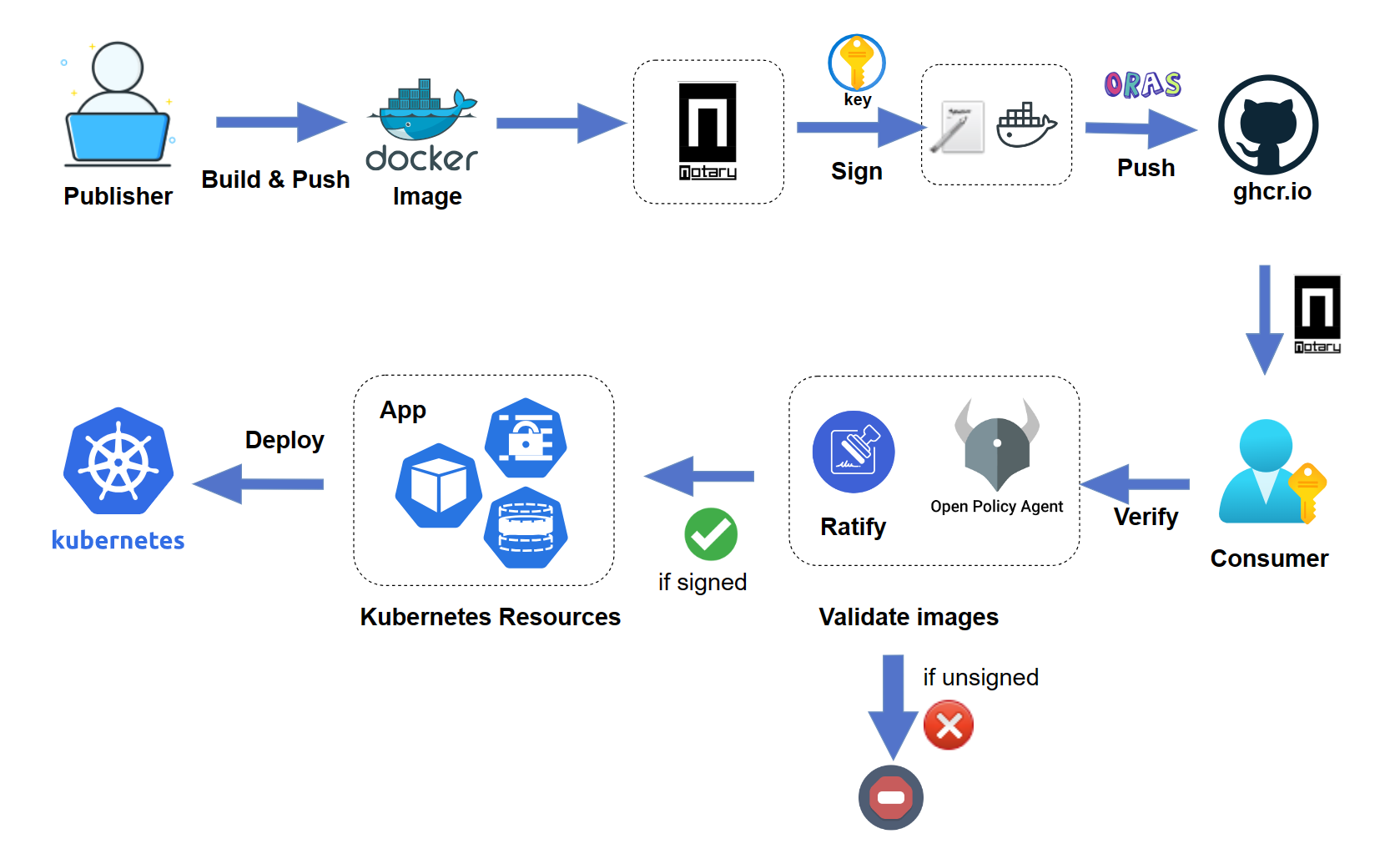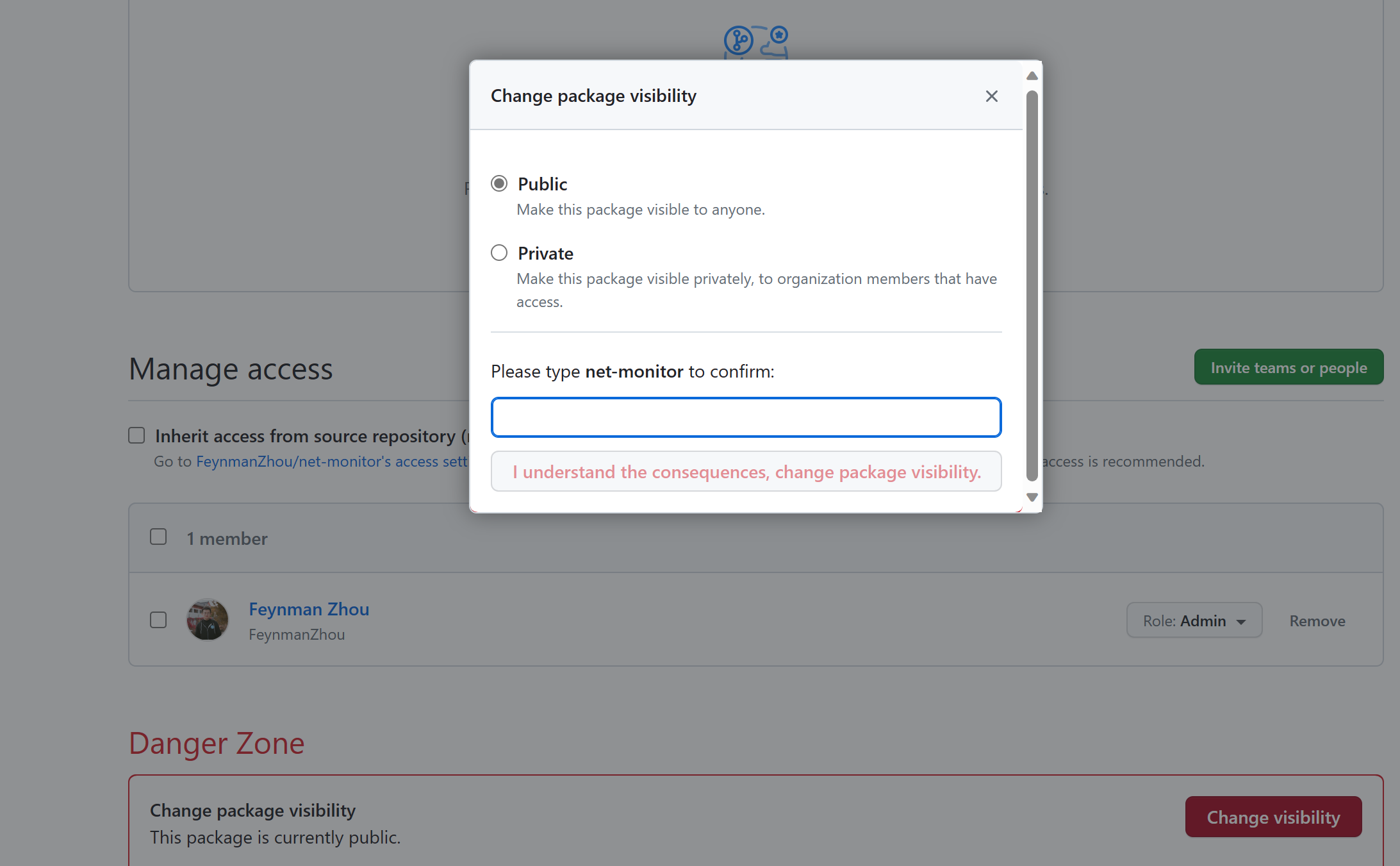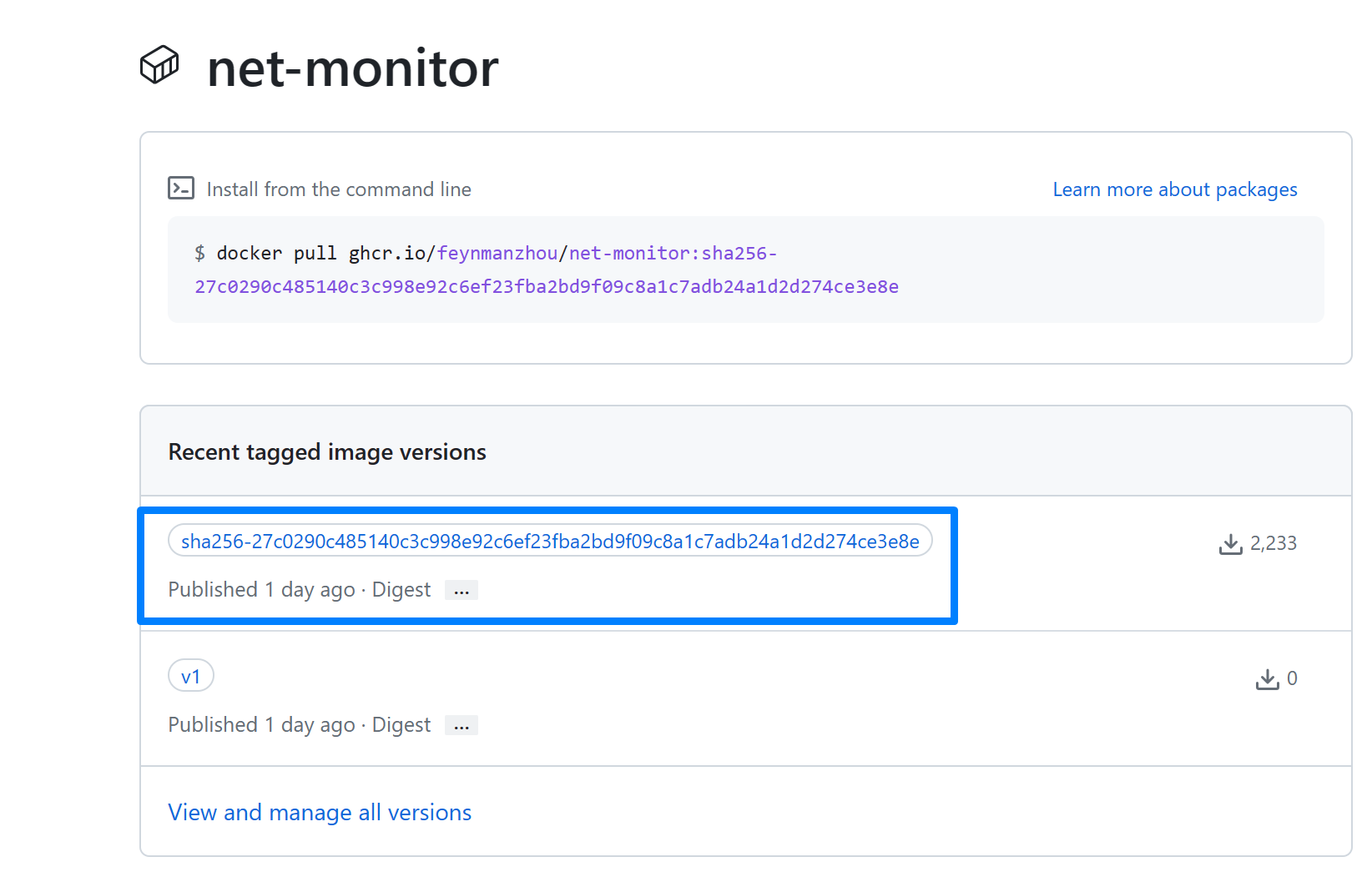# Sign and verify an image with Notation, Ratify, and Gatekeeper
The signed container images enable users to assure deployments are built from a trusted entity and verify images haven't been tampered with since their creation. The signed image ensures integrity and authenticity before the user pulls an image into any environment and avoid attacks.
[Notation](https://notaryproject.dev/) is a standards-based tool and library for signing and verifying OCI artifacts. It generates signatures and associates them with OCI artifacts to ensure integrity for the supply chain.
[Ratify](https://github.com/deislabs/ratify) is a verification engine as a binary executable and on Kubernetes which enables verification of artifact security metadata and admits for deployment only those that comply with policies you create. It works with [OPA Gatekeeper](https://github.com/open-policy-agent/gatekeeper) to provide fine-grained admission policy control capabilities for application deployment on Kubernetes.
This article walks you through the following end-to-end workflow:
- Build and sign an image in GHCR as a software publisher
- Verify the signed image as a software consumer
- Validating and enforcing only signed images are allowed to be deployed on Kubernetes
The typical scenario is when you want to secure your containerized package for a GitHub repository, you can apply this workflow to your project to ensure image integrity between software publisher and consumer.

## Prerequisites
- Kubernetes v1.20 or higher (You can use [minikube](https://minikube.sigs.k8s.io/docs/start/) if you are new to Kubernetes)
- Helm v3
## Create an OCI-compatible registry
Create and run an OCI-compatible registry on your development computer using the [distribution/distribution](https://github.com/distribution/distribution) with the [image deletion](https://docs.docker.com/registry/spec/api/#deleting-an-image) enabled. The following command creates a registry that is accessible at `localhost:5001`.
```console
docker run -d -p 5001:5000 -e REGISTRY_STORAGE_DELETE_ENABLED=true --name registry registry
```
## Add an image to the registry
The following commands build and push the [wabbit-networks/net-monitor](https://github.com/wabbit-networks/net-monitor#main) container image to your container registry. Notation supports OCI v1.1 and v1.0 compliant registries. In this article, we use ghcr.io as a sample registry.
```console
docker build -t localhost:5001/net-monitor:v1 https://github.com/wabbit-networks/net-monitor.git#main
```
Log in to ghcr.io with Docker. You can follow this [guide](https://docs.github.com/en/packages/working-with-a-github-packages-registry/working-with-the-container-registry#authenticating-with-a-personal-access-token-classic) to get the your personal GitHub Token.
```
echo $CR_PAT | docker login ghcr.io -u $YOUR_USER_NAME --password-stdin
```
Push the image to ghcr.io. You can record the image digest from the output.
```
docker push ghcr.io/$namespace/net-monitor:v1
```
You can record the image digest from the output. For example, the image digest is `ghcr.io/feynmanzhou/net-monitor@sha256:27c0290c485140c3c998e92c6ef23fba2bd9f09c8a1c7adb24a1d2d274ce3e8e`. Set the environment variable for this image digest.
```
IMAGE=ghcr.io/$namespace/net-monitor@sha256:27c0290c485140c3c998e92c6ef23fba2bd9f09c8a1c7adb24a1d2d274ce3e8e
```
Change the package visibility from private to public on GitHub Package settings. It will allow Notation and Ratify to pull the images from the GHCR registry without authentication configuration. See [Configuring a package's access control and visibility](https://docs.github.com/en/packages/learn-github-packages/configuring-a-packages-access-control-and-visibility) for details.

## Install Notation CLI
Install the latest version on Linux. Follow the [installation guide](https://notaryproject.dev/docs/installation/cli/) for other platforms.
```
curl -LO https://github.com/notaryproject/notation/releases/download/v$NOTATION_VERSION/notation_$NOTATION_VERSION\_linux_amd64.tar.gz
tar xvzf -C /usr/bin/ notation
```
## Generate a test key and self-signed certificate
Use `notation cert generate-test` to generate a test RSA key for signing artifacts, and a self-signed X.509 test certificate for verifying artifacts. Please note the self-signed certificate should be used for testing or development purposes only.
The following command generates a test key and a self-signed X.509 certificate. With the `--default` flag, the test key is set as a default signing key.
```console
notation cert generate-test --default "ratify-sample.io"
```
Use `notation cert ls` to confirm the certificate is stored in the trust store.
```console
notation cert ls
```
## Sign the image
Sign the sample image with the flag `--signature-format` to use [COSE](https://datatracker.ietf.org/doc/html/rfc8152/) signature format. in ghcr.io.
```
notation sign --signature-format cose $IMAGE
```
The generated signature is pushed to the registry and the digest of the container image returned.
Use `notation ls` to show the signature associated with the container image.
```
$ notation ls $IMAGE
ghcr.io/feynmanzhou/net-monitor@sha256:27c0290c485140c3c998e92c6ef23fba2bd9f09c8a1c7adb24a1d2d274ce3e8e
└── application/vnd.cncf.notary.signature
└── sha256:f4c1e923d1f2a7b76513c889a0db548a093f422d06ac6b83ce7243e0c8fa7805
```
You can find the signature has also been pushed to the GHCR registry associated with the signed image.

## Create a trust policy
To verify the container image, configure the trust policy to specify trusted identities that sign the artifacts, and level of signature verification to use. For more details, see [trust policy spec](https://github.com/notaryproject/notaryproject/blob/main/specs/trust-store-trust-policy.md#trust-policy).
Create a JSON file with the following trust policy, for example:
```
cat <<EOF > ./trustpolicy.json
{
"version": "1.0",
"trustPolicies": [
{
"name": "ratify-sample-images",
"registryScopes": [ "*" ],
"signatureVerification": {
"level" : "strict"
},
"trustStores": [ "ca:ratify-sample.io" ],
"trustedIdentities": [
"*"
]
}
]
}
EOF
```
Import the trust policy configuration from a JSON file.
```
notation policy import ./trustpolicy.json
```
## Verify the image signature as a software consumer
As a consumer, verify the signed image before using it.
```
notation verify $IMAGE
```
You can also check the signature digest and inspect the signature and its certificate information to make sure the image is produced from a trusted identity.
```
notation inspect $IMAGE
```
## Verify the containe image before deploying to Kubernetes
Try out Ratify in Kubernetes through OPA Gatekeeper as the admission controller. It will enforce only signed images can be deployed to Kubernetes.
Set up Gatekeeper with [external data](https://open-policy-agent.github.io/gatekeeper/website/docs/externaldata).
```bash
helm repo add gatekeeper https://open-policy-agent.github.io/gatekeeper/charts
helm install gatekeeper/gatekeeper \
--name-template=gatekeeper \
--namespace gatekeeper-system --create-namespace \
--set enableExternalData=true \
--set validatingWebhookTimeoutSeconds=5 \
--set mutatingWebhookTimeoutSeconds=2
```
Install the lastest version of Ratify. Specify the certificate generated by Notation for verification purposes.
```
helm repo add ratify https://deislabs.github.io/ratify
helm install ratify \
ratify/ratify --atomic \
--namespace gatekeeper-system \
--set-file notaryCert=ghcr-networks.io.crt
```
Apply the constrait to enforce Gatekeeper policy to allow only signed images can be deployed on Kubernetes:
```
kubectl apply -f https://deislabs.github.io/ratify/library/default/template.yaml
kubectl apply -f https://deislabs.github.io/ratify/library/default/samples/constraint.yaml
```
Deploy the sample image signed by Notation. Ratify will verify if this image has a valid signature.
```
$ kubectl run ratify-signed --image=$IMAGE
/net-monitor@sha256:27c0290c485140c3c998e92c6ef23fba2bd9f09c8a1c7adb24a1d2d274ce3e8e
pod/demo created
```
Check the signature associated with the image.
```
notation ls $IMAGE
```
Deploy an unsigned image to Kubernetes cluster. The deployment has been denied since the image has not been signed and doesn't meet the deployment criteria.
```
$ kubectl run demo --image=ghcr.io/feynmanzhou/notation/alpine@sha256:1304f174557314a7ed9eddb4eab12fed12cb0cd9809e4c28f29af86979a3c870
Error from server (Forbidden): admission webhook "validation.gatekeeper.sh" denied the request: [ratify-constraint] Subject failed verification: ghcr.io/feynmanzhou/notation/alpine@sha256:1304f174557314a7ed9eddb4eab12fed12cb0cd9809e4c28f29af86979a3c870
```
Inspect the logs to get the detailed error message from the Ratify Pod.
```
$ kubectl logs ratify-xxxx -n gatekeeper-system
{
"subject": "ghcr.io/feynmanzhou/notation/alpine@sha256:1304f174557314a7ed9eddb4eab12fed12cb0cd9809e4c28f29af86979a3c870",
"isSuccess": false,
"message": "verification failed: no referrers found for this artifact"
}
···
```
Deploy a signed image with an expired certificate.
```
kubectl run sample --image=ghcr.io/feynmanzhou/alpine:latest@sha256:1304f174557314a7ed9eddb4eab12fed12cb0cd9809e4c28f29af86979a3c870
Error from server (Forbidden): admission webhook "validation.gatekeeper.sh" denied the request: [ratify-constraint] Subject failed verification: ghcr.io/feynmanzhou/alpine:latest@sha256:1304f174557314a7ed9eddb4eab12fed12cb0cd9809e4c28f29af86979a3c870
```
Inspect the logs to get the detailed error message from the Ratify Pod. You can find that verification failed caused by an invalid signature.
```
{
"isSuccess": false,
"verifierReports": [
{
"isSuccess": false,
"name": "notaryv2",
"message": "an error thrown by the verifier: failed to verify signature, err: signature is not produced by a trusted signer",
···
```
## See it process in action
### Sign container image with Notation
<iframe width="560" height="315" src="https://www.youtube.com/embed/nNgQxokU36E" title="YouTube video player" frameborder="0" allow="accelerometer; autoplay; clipboard-write; encrypted-media; gyroscope; picture-in-picture; web-share" allowfullscreen></iframe>
### Verify image integrity on Kubernetes with Ratify and Gatekeeper
<iframe width="560" height="315" src="https://www.youtube.com/embed/fdmdEijlUiI" title="YouTube video player" frameborder="0" allow="accelerometer; autoplay; clipboard-write; encrypted-media; gyroscope; picture-in-picture; web-share" allowfullscreen></iframe>